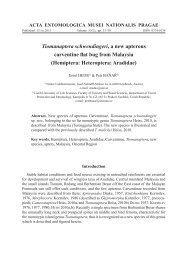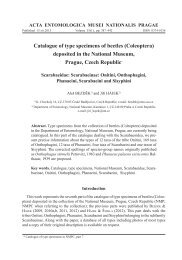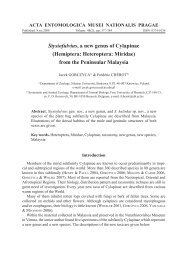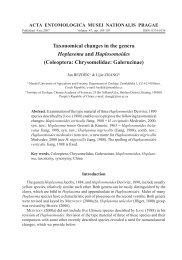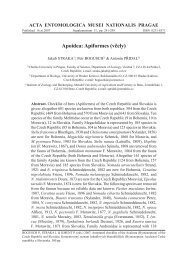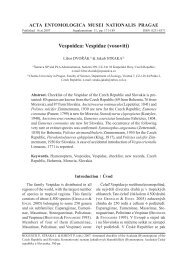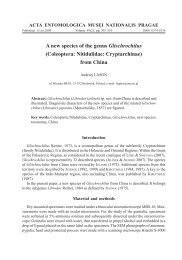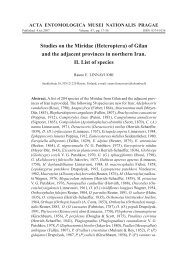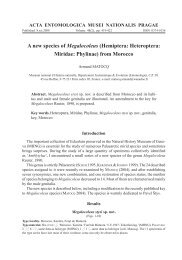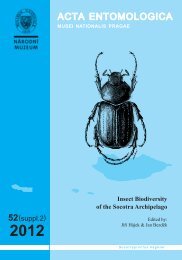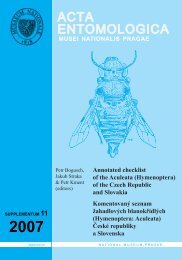Revision of the Palaearctic species of the Coccinella ...
Revision of the Palaearctic species of the Coccinella ...
Revision of the Palaearctic species of the Coccinella ...
Create successful ePaper yourself
Turn your PDF publications into a flip-book with our unique Google optimized e-Paper software.
136<br />
KOVÁŘ: <strong>Coccinella</strong> transversoguttata <strong>species</strong> group and notes on o<strong>the</strong>r <strong>Coccinella</strong><br />
Ventral surface moderately shiny, covered with dense, greyish-white, on distal part <strong>of</strong> tibiae<br />
pale ochraceous pubescence. Setae usually as long as 4-6 diameters, in middle <strong>of</strong> metasternum<br />
and <strong>of</strong> abdominal ventrites as 3-4 diameters, and on lateral parts <strong>of</strong> body at most as 6-<br />
8 diameters <strong>of</strong> eye facet. Propleura horizontal, in anterior half widely longitudinally excavated,<br />
gradually impressed towards antero-lateral corners <strong>of</strong> prosternum, forming indistinct groove<br />
for reception <strong>of</strong> antennal tip. Surface obsoletely reticulate, shallowly punctate, punctures equal<br />
to eye facets or indistinct; small area close to antero-lateral corners <strong>of</strong> prosternum with fine<br />
dense oblique wrinkles. Epipleuron about 1.55 (1.47-1.69) times as wide as base <strong>of</strong> mesosternum,<br />
feebly sloping dorso-laterally, ra<strong>the</strong>r deeply and widely excavated in anterior 0.7. Surface<br />
obsoletely rugose, densely covered with shallow punctures <strong>of</strong> inequal size but usually<br />
larger than eye facets. Prosternum moderately convex in middle, its anterior margin ra<strong>the</strong>r<br />
deeply semi-elliptically emarginate. Basisternal lobes ra<strong>the</strong>r narrow, flattened, at <strong>the</strong> narrowest<br />
part distinctly more than twice as wide as prosternal process. Prosternal process narrow,<br />
only finely saddle-shaped behind midlength, apex semicircular. Prosternal carinae parallel,<br />
reaching anterior third <strong>of</strong> length <strong>of</strong> prosternum. Surface <strong>of</strong> prosternum finely transversely<br />
wrinkled, finely and ra<strong>the</strong>r densely punctate, punctures becoming obsolete postero-laterally.<br />
Mesosternal process at base 1.18 (1.06-1.29) times as wide as long in middle, ra<strong>the</strong>r strongly<br />
convex. Anterior margin moderately carinulate, straight or very shallowly emarginate in middle.<br />
Surface without wrinkles or indistinctly transversely wrinkled, sometimes obsoletely reticulate,<br />
coarsely and nearly regularly punctate. Punctures separated by <strong>the</strong>ir diameter, becoming<br />
denser towards base, 1.2-1.5 times as large as eye facets. Metasternum 3.97 (3.75-4.26)<br />
times as long as mesosternal process, ra<strong>the</strong>r strongly transversely convex, flattened posteromedially.<br />
Medial longitudinal sulcus complete, slightly impressed except for anterior portion.<br />
Precoxal bulge well developed, transverse. Surface finely transversely wrinkled and finely<br />
punctate. Wrinkles becoming finer and very dense antero-laterally. Punctures along medial<br />
sulcus inequal in size and distribution, 0.6-1.2 times as large as eye facets, somewhat deeply<br />
impressed, usually sparse, becoming somewhat denser and shallower to indistinct along lateral<br />
margins. Abdominal ventrites 1-4 in medial third distinctly transversely convex, sides flattened.<br />
Ventrite 1 only finely saddle-shaped medially, with surface ra<strong>the</strong>r coarsely densely<br />
punctate; punctures 1.2-1.5 times as large as eye facets, separated by 0.25-0.5 <strong>the</strong>ir diameter,<br />
becoming smaller and sparser postero-medially. Femoral line V-shaped, inner part strongly<br />
arcuate at basal half, <strong>the</strong>n gradually straightened, shortly broken before meeting straight line<br />
before posterior margin <strong>of</strong> ventrite 1, and nearly crossing <strong>the</strong> outer, strongly oblique and<br />
nearly straight lateral line. Posterior margin <strong>of</strong> ventrite 5 in female straight, in male widely<br />
shallowly emarginate, that <strong>of</strong> ventrite 6 in female arcuate and distinctly acuminate, in male<br />
narrowly ra<strong>the</strong>r deeply arcuately emarginate. Moreover, ventrite 6 in male with shallow transversely<br />
oval impression in <strong>the</strong> middle. Legs long, slender, distal end <strong>of</strong> hind femora reaching<br />
a little over <strong>the</strong> outer margin <strong>of</strong> epipleuron. Hind tibia 7.44-8.02 times as longer as wide, outer<br />
margin feebly arcuate, inner one nearly straight. Tarsus moderately slender, tarsomere 3 reaching<br />
only a little over <strong>the</strong> midlength <strong>of</strong> <strong>the</strong> free part <strong>of</strong> tarsomere 2. Tarsal claw moderately slender,<br />
ra<strong>the</strong>r slightly curved dorsally, with sharp basal tooth situated submedially.<br />
Male genitalia. Tegmen moderately sized. Median lobe <strong>of</strong> aedeagus in larger basal portion<br />
subrectangular, in smaller apical one hastate, extended well beyond apices <strong>of</strong> parameres.



